 |
 |
 |
 |
 |
 |
 October 3rd, 2011, 07:05 AM
October 3rd, 2011, 07:05 AM
|
#1
|
|
Colonial Story Teller
 | Fleet Moderator | | | Colonial Fleets |
Join Date: Sep 2003
Location: New Orleans (Metairie), LA
Posts: 4,785
|
 Colonial Camping Unit...and an essay on it
Colonial Camping Unit...and an essay on it
Hi, folks,
I couldn't remember if I'd posted anything about THIS. This was a design I'd made several months ago for my Galactica: The Last Battlestar project.
=============================================
Colonial Camping Unit and Camping Situations
Sometimes, Colonial Warriors may be called upon to make extended reconnaissance on unexplored worlds, or near enemy territory, often without the support of a baseship. Some worlds can even prove to be very hostile. To aid them in this action, the Colonial Warriors can utilize camping units. These shelters are well equipped to accommodate up to four warriors for up to two sectons if necessary. That staying time can be extended on habitable worlds where the life-support equipment is not used, as long as disciplined rationing comes into play, or the warriors engage in hunting for food (which sometimes they do, just to have a break from the food packs stowed within the unit.)
The Colonial Camping Unit (or CCU, as it is informally referred to sometimes) is a technological marvel of survival, featuring a hardened exterior, capable of withstanding small arms fire (landram cannons will severely damage the CCU, and fighter weapons will destroy it) , and is sealed and pressurized for long term stays in hostile or toxic environments. Although it is waterproof, the CCU was not designed for aquatic excursions. It can even support the warriors in vacuum for a short time, when recovery operations warrant leaving the warriors in the unit while shuttles evac them from the landing zone to a waiting destroyer or battlestar. The exterior can even provide protection against radiological threats. Additionally, the external hull's skin can, if required, mimic the surrounding terrain coloring, to effectively camouflage the CCU into its surroundings, making it more difficult to spot visually from the air, or amidst trees in a dense jungle or forest.
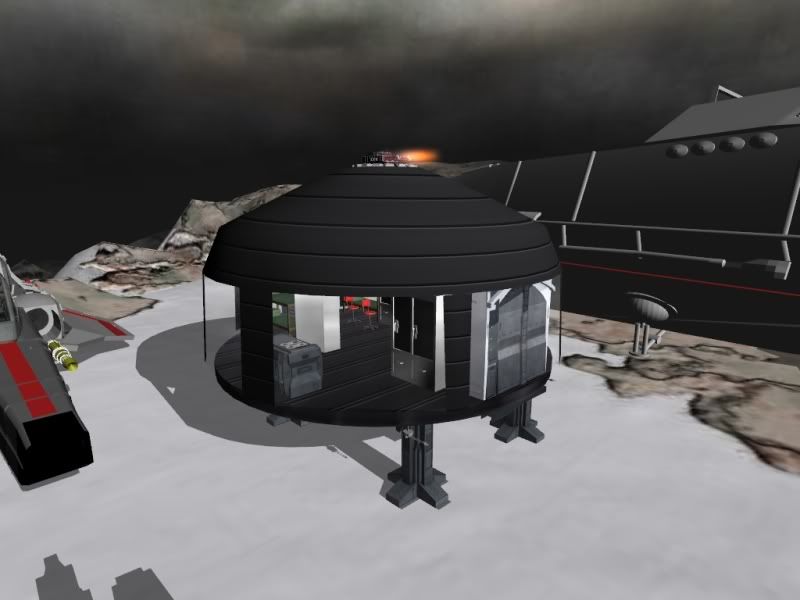
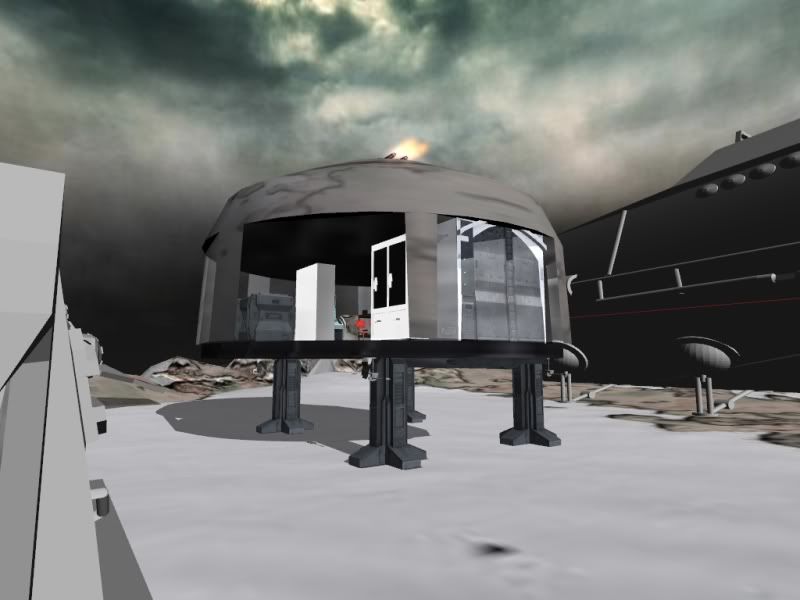
__________________
Don't be a fan. Don't be a victim!-Martok2112
|

|

|
|
 October 3rd, 2011, 07:06 AM
October 3rd, 2011, 07:06 AM
|
#2
|
|
Colonial Story Teller
 | Fleet Moderator | | | Colonial Fleets |
Join Date: Sep 2003
Location: New Orleans (Metairie), LA
Posts: 4,785
|
 Re: Colonial Camping Unit...and an essay on it
Re: Colonial Camping Unit...and an essay on it
All the consumables (life support, food, medicines, and other survival implements) will last four Colonial Warriors for up to two sectons.
The CCU houses a suite of equipment to support the warriors in the upper half of the habitat dome: A life support tank and recycler, potable water tank, tactical grade sensor and electronic countermeasures equipment, a small main generator to power the equipment, and a communications array capable of orbital communications range. A workstation located between the two bunk beds keeps the camping warriors apprised of systems status, runs the communications and electronic warfare suites, and processes information provided by the sensors. It also can directly control the defensive weaponry of the CCU.
In the habitat area of the dome, two bunk beds allow the four warriors to take sleep periods. Two wall lockers stow the warriors' clothing and gear. Another pair of wall lockers flanks either side of the airlock/entrance, containing hostile environment gear, should the warriors be required to make an excursion in such environs. They also contain repair equipment for the hazard suits, and for the warriors' weapons and small equipment. On one side of the habitat area, behind the starboard wall locker is a food storage container, holding two weeks worth of rations for all four warriors. The rations are small, concentrated food stuffs which are not exactly dining hall quality, but they are palatable enough, and provide the nutrition requirements for a Colonial Warrior. The warriors refer to these packets as R.P.M.'s (Ready Packaged Meals). The top of the food store container can be used to prep and heat the foodstuffs, should the warriors desire a cooked "meal". Again, on habitable worlds where the life support unit need not be engaged, the warriors can hunt for more substantially tasty food, and prepare real meals on the food storage and processing unit. Behind the portside wall locker, a medical equipment container/bed is placed, clearly painted in red. From this container, warriors can treat low level, non-life threatening injuries and illnesses. More dire injuries can be stabilized, but help would have to come quickly. The injured warrior(s) would have to be taken to a better equipped facility (such as a destroyer or battlestar) or be taken to the Medical Treatment Unit (MTU) when a small cluster of CCU's are deployed to form a basecamp.


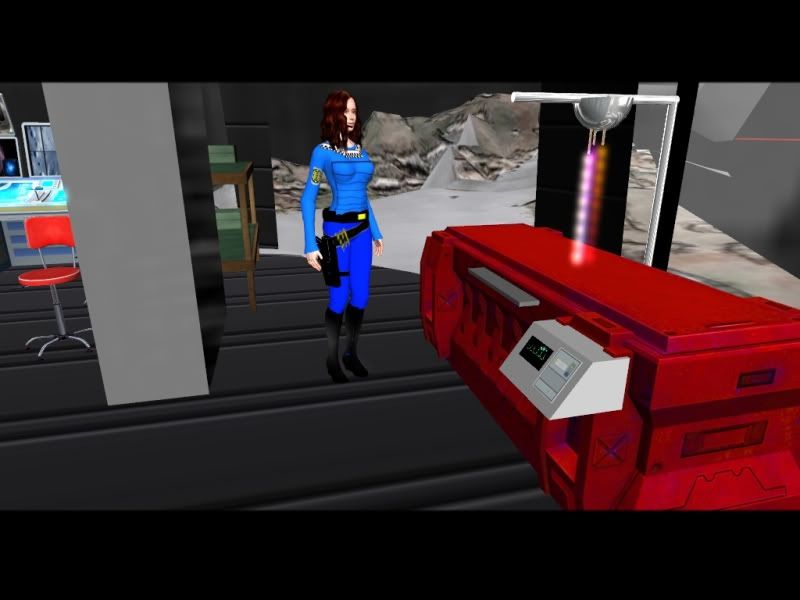
__________________
Don't be a fan. Don't be a victim!-Martok2112
|

|

|
|
 October 3rd, 2011, 07:06 AM
October 3rd, 2011, 07:06 AM
|
#3
|
|
Colonial Story Teller
 | Fleet Moderator | | | Colonial Fleets |
Join Date: Sep 2003
Location: New Orleans (Metairie), LA
Posts: 4,785
|
 Re: Colonial Camping Unit...and an essay on it
Re: Colonial Camping Unit...and an essay on it
Eight armored viewports surround the main cabin, although one is obfuscated by the airlock. The viewports can also be darkened up to maximum opacity, should the warriors need to block out extremely bright light. They will also automatically darken should a radiological detector pick up a nuclear warhead about to make nearby impact.
[The CCU is also designed to protect its warriors from intruders. Four twin- blaster cannons are mounted below the habitat dome, powered by generators contained in the armored support struts that keep the dome above ground. These blasters are designed to fend off any thing from a pack of wild, dangerous animals up to a small squad of Cylon Centurions. They can also cover the warriors during a retreat to the CCU. A small double blaster cannon atop the habitat dome can protect the warriors from an aerial attack. In basecamp formation, the combined double blaster cannons of all the CCU's form an impressive anti-starfighter screen, especially when used in concert with warriors manning landram-mounted weapons.
The four armored struts below the CCU keep the unit just over two metrons off the ground. In addition to each strut housing a laser generator, the struts also can fire anchors into the ground in the event of an incoming high-powered shockwave, such as that from the detonation of a low-yield tactical nuclear device, or a large tidal wave.
The boarding lift can raise or lower all four warriors in standard uniform fairly quickly into or down from the CCU's airlock, although the accommodations might be a bit cramped on the way up or down. On habitable worlds, the warriors can actually scramble up into the habitat area of the CCU, thanks to a couple of built-on ladders, should the tactical situation require hastier entry into the CCU than the lift can provide. On less hospitable worlds, the warrior would have to rely on the cover of the two anti-personnel blasters flanking the lift until it can get him/her up into the safety of the airlock. Three armor plates provide additional partial protection against incoming fire.

The airlock is the ingress/egress port of the CCU. On a habitable world, it is simply an entry/exit portal. On toxic worlds, or in vacuum, the airlock serves its full function, protecting those on the inside of the CCU from the hazardous gases beyond, while their fellow warriors board or depart. The airlock also serves as a decontamination unit to render toxic and/or radioactive traces and bacterium inert when a warrior boards from the dangerous atmosphere.
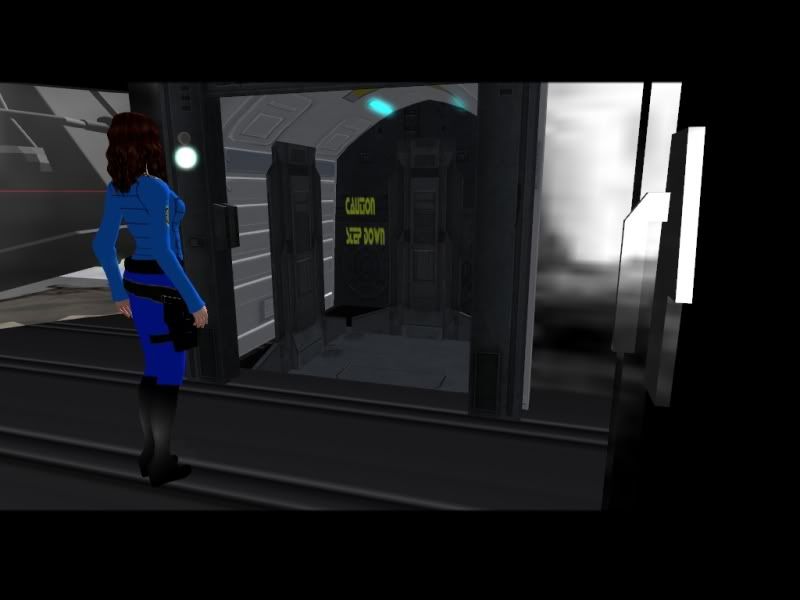
A basecamp configuration consists of five CCU's, a 3CU, and an MTU, and two landrams. Four of the CCU's are placed at the four corners of the established perimeter, while the 3CU sits in the center of the encampment, with the MTU right beside it. The medical staff (two doctors and two nurses) are housed in the fifth CCU, which is located beside the MTU. Additionally, the four corner CCU's are able to create a sensor net between them to alert the warriors of intruders entering the perimeter. When that happens, any anti-personnel turrets that are in bearing aspect will train on the intruder, and will automatically fire a warning shot at the ground in front of the intruder. This should effectively stay the intruder until warriors arrive to investigate.
Colonial Camp Command Units (3CU's) are somewhat wider than the typical CCU, and house four senior officers, but is also equipped with higher grade sensor, countermeasure, and comms equipment. It can hold all the personnel in the basecamp for combat briefings and conferences. It possesses the same defensive firepower as a CCU, and is similarly hardened against the potential threats listed earlier in this essay. 3CU's are usually only deployed in a basecamp situation.
Medical Treatment Units (MTU's) are roughly the same size as a 3CU, and are as well equipped as a life-station on a destroyer. They house four bio-beds, four standard medical beds, and has the capability to treat even injuries or illnesses that are life-threatening.
Overall, Colonial Warriors in a camping/prolonged recon situation could not ask for much better shelter when separated from their baseship. In fact, some warriors actually relish the thought of spending time in a CCU simply because they feel about as well protected in it as they would aboard a battlestar.
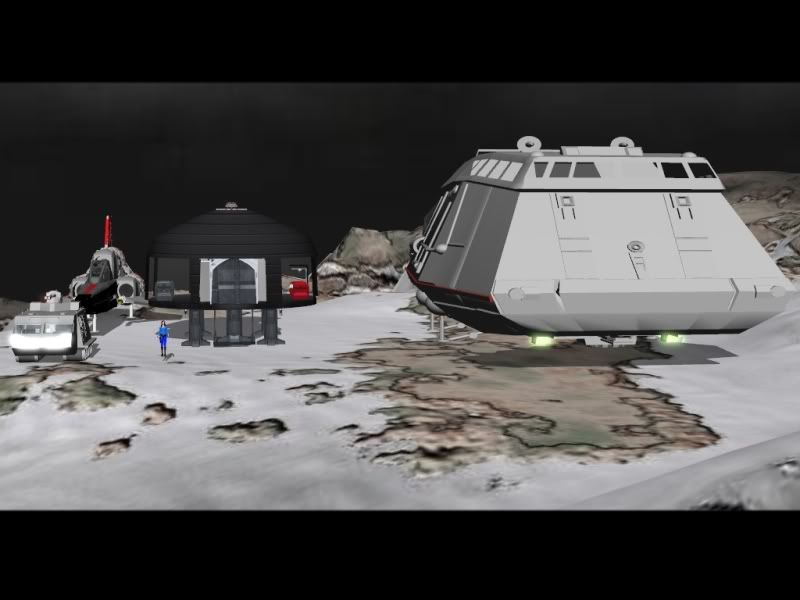
__________________
Don't be a fan. Don't be a victim!-Martok2112
|

|

|
|
 October 3rd, 2011, 07:07 AM
October 3rd, 2011, 07:07 AM
|
#4
|
|
Colonial Story Teller
 | Fleet Moderator | | | Colonial Fleets |
Join Date: Sep 2003
Location: New Orleans (Metairie), LA
Posts: 4,785
|
 Re: Colonial Camping Unit...and an essay on it
Re: Colonial Camping Unit...and an essay on it
DEPLOYMENT AND EXTRICATION of CCU's/BASECAMPS--
Deployment of the CCU for use in the field is an interesting process. When deployed from a battlestar, the CCU is released from set-in storage bays along the sides of the main hull, and sent out about a hundred metrons from the ship, where a heavy shuttle will tractor beam the CCU to its underside, and ferry it down to the planet. When setting up multiple CCU's for a better fortified encampment, more shuttles are called into play.
A destroyer, however, being an atmosphere-capable craft, can actually deliver an entire basecamp (five CCU's, a Colonial Camp Command Unit--informally called a 3CU, and a Medical Treatment Unit--aka MTU, and a pair of landrams) to the surface, lowering them via tractor beam when the destroyer is close enough to the surface.
The CCU's are dropped from the shuttle or destroyer (usually about ten metrons from the ground) and make a soft landing thanks to anti-grav generators that cushion their descent to ground zero. The anti-grav units cannot lift the CCU's off the ground, they would require more power than the on-board generators can produce...they are only designed to cushion the descent of the units. However, the anti-gravs CAN assist shuttles or destroyers in a "combat evacuation".
Extricating the CCU or basecamp under benign conditions (or at least, favorable conditions) involves shuttles coming down to tractor the CCU/basecamp back up to the waiting baseship. Destroyers can simply return the CCU's to their storage bays in the hull, so that reduces transition time. The encamped warriors are able ride up in the CCU's in this situation. Landrams are returned via shuttles.
Returning a CCU/basecamp to a battlestar is a rather slingshot process. The shuttles land first, to take on the warriors and recover any landrams, and then move to tractor beam the CCU's. The shuttles approach the battlestar's recovery bays, and release the CCU's toward the bay opening, letting inertia, and then tractor/repulsor beams do all the work, taking the units into the bay, where they will be moved from there, back to the deployment bays along the hull, where they will be restocked for the next deployment.
A "combat evacuation" is a rather spectacular event to behold, assuming you yourself are not directly under fire. Of course, there is the chaos of weapons fire all around as shuttles come screaming out of the sky, usually supported by Kraits, Vipers, and/or Raptors and Mambas.
A destroyer recovering her CCU's is a ferocious sight to see, as her kinetic point defense weaponry blazes a deadly defensive field around the basecamp. Her tractor beams gather up the CCU's, aided by the CCU's anti-grav generators to reduce contact to grip time, and scoop the CCU's into the recovery bay. The warriors ride in the CCU's, maintaining fire with the CCU's defensive armaments until inside the protection of the recovery bay.
In a recovery by a battlestar, shuttles make a rapid approach to the LZ, firing up their tractor beams, while the warriors inside the CCU's fire up the anti-grav units to lessen the strain of the initial pick-up. It is, quite literally, a swoop-up as the shuttle practically flies over the CCU and picks it up almost without stopping. (It is also quite a jolt for the warriors inside the CCU.) The warriors ride in the CCU on their rapid ascent toward the waiting battlestar, relying on the CCU's ability to protect them from the vacuum of space.) If the shuttles make it back to the battlestar's range safely with their precious cargo in tow, the shuttles release the tractor beams, flinging the CCU's into the bays, but this time, the CCU's have to use their own anti-gravs to slow their run into the bays, since target acquisition time with a tractor/repulsor beam from the landing bay itself is a painfully slow process in the heat of battle. The CCU's don't always land neatly in the bay in such scenarios, but they do land intact, their warriors momentarily jarred from the experience...and occasionally suffering mild injuries. Surviving a CCU/basecamp "combat evacuation" usually makes for some colorful storytelling.
Shuttles making combat evacs for landrams do so quickly, but are at greater risk than those picking up CCU's. Guided by the flashing battle light on the landram, a shuttle makes a hasty landing mere metrons in front of the ground vehicle, with the aft bay door opening during the last ten microns of the approach. The micron the shuttle kisses the ground, the landram driver steps on the pedal and lurches the vehicle up the ramp and into the stowage bay on the shuttle. Before the landram is even locked into place, the shuttle pilot has already begun the ship's rapid ascent for space. In fact, as soon as the onboard sensor reports that the landram has cleared the threshhold, the shuttle pilot races for the stars.
__________________
Don't be a fan. Don't be a victim!-Martok2112
|

|

|
|
 |
 Posting Rules
Posting Rules
|
You may not post new threads
You may not post replies
You may not post attachments
You may not edit your posts
HTML code is Off
|
|
|
|
 |
 |
 |
 |
|

 For fans of the Classic Battlestar Galactica series
For fans of the Classic Battlestar Galactica series
|
|
 |


